An Ayurvedic Approach to Exercise
Move with intention, balance your doshas, and cultivate holistic vitality.
In Ayurveda, movement is not simply about burning calories—it’s about aligning with your natural constitution (dosha), honoring your energy, and cultivating balance between body, mind, and spirit. Whether you're a fiery Pitta, grounded Kapha, or airy Vata, your approach to fitness can either support your vitality—or deplete it.
Here’s how to apply Ayurvedic principles to create a nourishing, sustainable movement ritual that supports long-term wellness.
Know Your Dosha: Exercise in Alignment with Your Nature
In Ayurveda, we are all born with a unique balance of the three doshas: Vata, Pitta, and Kapha. Each dosha has distinct qualities that influence how we move, recover, and feel.
VATA (Air & Ether)
Vata types tend to be quick, light, and energetic—but can also be prone to fatigue and instability.
Best movement: Gentle, grounding activities like yoga, walking, slow dancing, or tai chi.
Focus: Stability, rhythm, and breath awareness. Avoid overexertion or high-impact routines.
PITTA (Fire & Water)
Pittas are strong, competitive, and driven. They benefit from calming and non-heated movement.
Best movement: Swimming, cycling, moderate hikes, or cooling yoga styles.
Focus: Flow, relaxation, and reducing internal heat. Avoid over-intensity or heated environments.
KAPHA (Earth & Water)
Kaphas are naturally grounded and strong, but may need stimulation to stay active.
Best movement: Energizing workouts like dance, HIIT, brisk walking, or vinyasa yoga.
Focus: Stimulation, endurance, and consistency. Avoid sedentary routines or excessive rest.
Rituals Before and After Movement
Ayurveda encourages preparation and recovery to keep the body resilient and balanced.
Before: Awaken and Warm the Body
-
Self-massage (Abhyanga): Use warm sesame or coconut oil to stimulate circulation and calm the nervous system.
-
Joint mobilization: Gentle movements like shoulder rolls, neck circles, or ankle rotations warm up the joints and enhance fluidity.
After: Ground and Restore
-
Gentle cool-down: Include slow stretching, forward bends, and calming breathwork.
-
Restorative poses: Take a few moments in savasana or child’s pose to integrate the movement.
Ayurvedic Diet & Hydration for Exercise Support
Fuel your body according to your dosha and support digestion and energy flow.
-
Favor seasonal, whole foods that suit your dosha: warming for Vata, cooling for Pitta, and light for Kapha.
-
Stay hydrated with warm or room-temperature water. Avoid iced beverages, which can weaken agni (digestive fire).
-
Time your meals mindfully: avoid intense exercise right after eating and nourish yourself after movement with grounding or revitalizing foods.
Rest, Sleep & Listening In
Recovery is just as important as activity.
-
Honor rest days and avoid over-scheduling workouts. Movement should energize, not deplete.
-
Prioritize sleep as a key pillar of repair and hormonal balance. Aim for 7–9 hours of quality rest.
-
Stay attuned to your body’s signals—some days call for dynamic flow, others for stillness.
Final Thoughts
An Ayurvedic approach to exercise is not about following trends—it’s about tuning into your inner rhythm and cultivating vitality at every stage of life. By aligning movement with your dosha, honoring rest, and practicing conscious self-care, you support your longevity and radiance from the inside out.








Leave a comment